Catenin-β Monoclonal Antibody(4F2)
- 货号:YM3403
- 应用:WB;IF;IHC
- 种属:Human;Mouse;Rat;Zebrafish
- 靶点:
- Catenin-β
- 简介:
- >>Rap1 signaling pathway;>>Wnt signaling pathway;>>Hippo signaling pathway;>>Focal adhesion;>>Adherens junction;>>Signaling pathways regulating pluripotency of stem cells;>>Leukocyte transendothelial migration;>>Melanogenesis;>>Thyroid hormone signaling pathway;>>Cushing syndrome;>>Alcoholic liver disease;>>Alzheimer disease;>>Pathways of neurodegeneration - multiple diseases;>>Bacterial invasion of epithelial cells;>>Salmonella infection;>>Hepatitis C;>>Human cytomegalovirus infection;>>Human papillomavirus infection;>>Kaposi sarcoma-associated herpesvirus infection;>>Pathways in cancer;>>Proteoglycans in cancer;>>Colorectal cancer;>>Endometrial cancer;>>Prostate cancer;>>Thyroid cancer;>>Basal cell carcinoma;>>Breast cancer;>>Hepatocellular carcinoma;>>Gastric cancer;>>Arrhythmogenic right ventricular cardiomyopathy;>>Fluid shear stress and atherosclerosis
- 基因名称:
- CTNNB1 CTNNB OK/SW-cl.35 PRO2286
- 蛋白名称:
- Catenin-β;b-catenin;Beta catenin;Beta-catenin;Cadherin associated protein;Catenin (cadherin associated protein), beta 1, 88 kDa;Catenin beta 1;Catenin beta-1;CATNB;CHBCAT;CTNB1_HUMAN;CTNNB;CTNNB1;DKFZ
- Human Gene Id:
- 1499
- Human Swiss Prot No:
- P35222
- Mouse Swiss Prot No:
- Q02248
- Rat Swiss Prot No:
- Q9WU82
- 免疫原:
- Recombinant Protein of Catenin-β
- 特异性:
- The antibody detects endogenous Catenin-β protein.
- 组成:
- PBS, pH 7.4, containing 0.5%BSA, 0.02% sodium azide as Preservative and 50% Glycerol.
- 来源:
- Monoclonal, Mouse
- 稀释:
- WB 1:1000-2000 IHC 1:200-500 IF 1:200
- 纯化工艺:
- The antibody was affinity-purified from mouse ascites by affinity-chromatography using epitope-specific immunogen.
- 储存:
- -15°C to -25°C/1 year(Do not lower than -25°C)
- 其他名称:
- CTNNB1;CTNNB;OK/SW-cl.35;Catenin beta-1;Beta-catenin
- 实测条带:
- 92kD
- 背景:
- The protein encoded by this gene is part of a complex of proteins that constitute adherens junctions (AJs). AJs are necessary for the creation and maintenance of epithelial cell layers by regulating cell growth and adhesion between cells. The encoded protein also anchors the actin cytoskeleton and may be responsible for transmitting the contact inhibition signal that causes cells to stop dividing once the epithelial sheet is complete. Finally, this protein binds to the product of the APC gene, which is mutated in adenomatous polyposis of the colon. Mutations in this gene are a cause of colorectal cancer (CRC), pilomatrixoma (PTR), medulloblastoma (MDB), and ovarian cancer. Alternative splicing results in multiple transcript variants. [provided by RefSeq, Aug 2016],
- 功能:
- disease:A chromosomal rearrangement involving CTNNB1 may be a cause of salivary gland pleiomorphic adenomas (PA) [181030]. Pleiomorphic adenomas are the most common benign epithelial tumors of the salivary gland. Translocation t(3;8)(p21;q12) with PLAG1.,disease:Activating mutations in CTNNB1 have oncogenic activity resulting in tumor development. Somatic mutations are found in various tumor types, including colon cancers, ovarian and prostate carcinomas, hepatoblastoma (HB), hepatocellular carcinoma (HCC). HBs are malignant embryonal tumors mainly affecting young children in the first three years of life.,disease:Defects in CTNNB1 are a cause of medulloblastoma (MDB) [MIM:155255]. MDB is a malignant, invasive embryonal tumor of the cerebellum with a preferential manifestation in children.,disease:Defects in CTNNB1 are a cause of pilomatrixoma (PTR) [MIM:132600]; a common benign skin tum
- 细胞定位:
- Cytoplasm . Nucleus . Cytoplasm, cytoskeleton . Cell junction, adherens junction . Cell junction . Cell membrane . Cytoplasm, cytoskeleton, microtubule organizing center, centrosome. Cytoplasm, cytoskeleton, spindle pole. Cell junction, synapse . Cytoplasm, cytoskeleton, cilium basal body . Colocalized with RAPGEF2 and TJP1 at cell-cell contacts (By similarity). Cytoplasmic when it is unstabilized (high level of phosphorylation) or bound to CDH1. Translocates to the nucleus when it is stabilized (low level of phosphorylation). Interaction with GLIS2 and MUC1 promotes nuclear translocation. Interaction with EMD inhibits nuclear localization. The majority of beta-catenin is localized to the cell membrane. In interphase, colocalizes with CROCC between CEP250 puncta at the proximal end of cent
- 组织表达:
- Expressed in several hair follicle cell types: basal and peripheral matrix cells, and cells of the outer and inner root sheaths. Expressed in colon. Present in cortical neurons (at protein level). Expressed in breast cancer tissues (at protein level) (PubMed:29367600).
Activation of liver X receptor promotes hippocampal neurogenesis and improves long‐term cognitive function recovery in acute cerebral ischemia‐reperfusion mice. JOURNAL OF NEUROCHEMISTRY J Neurochem. 2020 Jul;154(2):205-217 WB Mouse 1 : 1000 hippocampus
货号:YM3403
Developmental protein kinase C hyper-activation results in microcephaly and behavioral abnormalities in zebrafish. Translational Psychiatry 2018 Oct 23 WB,IHC Zebrafish brain
货号:YM3403
CPNE1 silencing inhibits the proliferation, invasion and migration of human osteosarcoma cells. ONCOLOGY REPORTS 2017 Dec 04 WB Human 1:1000 Saos-2 cell
货号:YM3403
Relationship between coronary artery calcification and calcium deposition in the myocardium:. JOURNAL OF INTERNATIONAL MEDICAL RESEARCH 2019 May 22 WB Human myocardial tissue
货号:YM3403
Wang, Nuan, et al. "MARCH1 Interacts with β-Catenin as a New Oncogene for Gastric Cancer." (2021).
货号:YM3403
- June 19-2018
- WESTERN IMMUNOBLOTTING PROTOCOL
- June 19-2018
- IMMUNOHISTOCHEMISTRY-PARAFFIN PROTOCOL
- June 19-2018
- IMMUNOFLUORESCENCE PROTOCOL
- September 08-2020
- FLOW-CYTOMEYRT-PROTOCOL
- May 20-2022
- Cell-Based ELISA│解您多样本WB检测之困扰
- July 13-2018
- CELL-BASED-ELISA-PROTOCOL-FOR-ACETYL-PROTEIN
- July 13-2018
- CELL-BASED-ELISA-PROTOCOL-FOR-PHOSPHO-PROTEIN
- July 13-2018
- Antibody-FAQs
- 产品图片
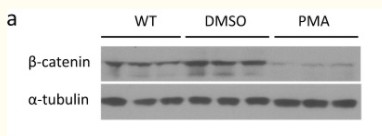
- Liu, Taian, et al. "Developmental protein kinase C hyper-activation results in microcephaly and behavioral abnormalities in zebrafish." Translational psychiatry 8 (2018).
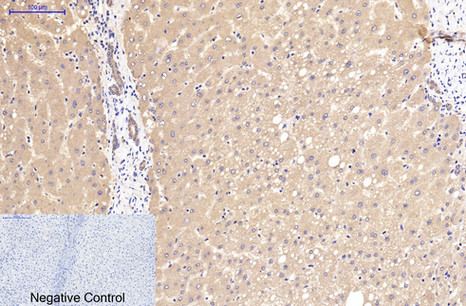
- Immunohistochemical analysis of paraffin-embedded Human-liver tissue. 1,Catenin-β Monoclonal Antibody(4F2) was diluted at 1:200(4°C,overnight). 2, Sodium citrate pH 6.0 was used for antibody retrieval(>98°C,20min). 3,Secondary antibody was diluted at 1:200(room tempeRature, 30min). Negative control was used by secondary antibody only.
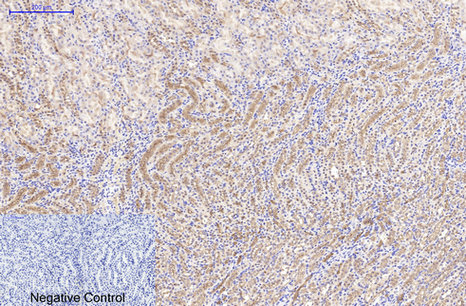
- Immunohistochemical analysis of paraffin-embedded Mouse-kidney tissue. 1,Catenin-β Monoclonal Antibody(4F2) was diluted at 1:200(4°C,overnight). 2, Sodium citrate pH 6.0 was used for antibody retrieval(>98°C,20min). 3,Secondary antibody was diluted at 1:200(room tempeRature, 30min). Negative control was used by secondary antibody only.
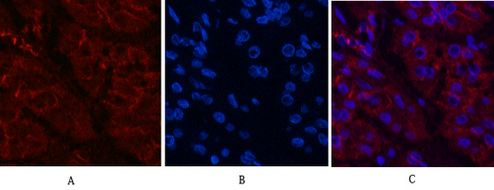
- Immunofluorescence analysis of Human-stomach-cancer tissue. 1,Catenin-β Monoclonal Antibody(4F2)(red) was diluted at 1:200(4°C,overnight). 2, Cy3 labled Secondary antibody was diluted at 1:300(room temperature, 50min).3, Picture B: DAPI(blue) 10min. Picture A:Target. Picture B: DAPI. Picture C: merge of A+B
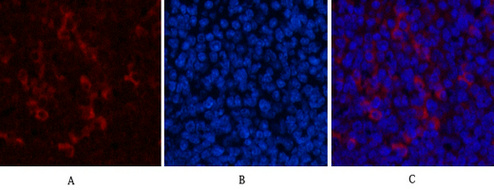
- Immunofluorescence analysis of Mouse-spleen tissue. 1,Catenin-β Monoclonal Antibody(4F2)(red) was diluted at 1:200(4°C,overnight). 2, Cy3 labled Secondary antibody was diluted at 1:300(room temperature, 50min).3, Picture B: DAPI(blue) 10min. Picture A:Target. Picture B: DAPI. Picture C: merge of A+B
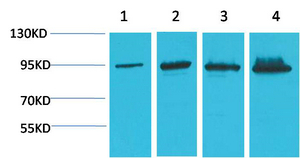
- Western blot analysis of 1) Hela, 2) 293T, 3) Mouse Liver Tissue, 4) Rat Liver Tissue using Catenin-β Monoclonal Antibody.
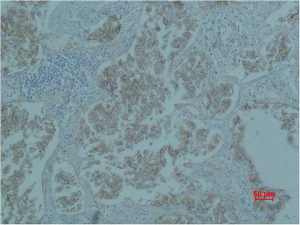
- Immunohistochemical analysis of paraffin-embedded Human Lung caricnoma using Catenin-β Monoclonal Antibody.



